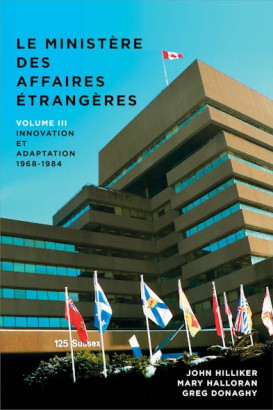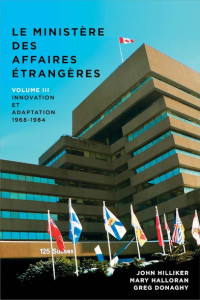Le ministère des Affaires extérieures du Canada : Volume III : Innovation et adaptation, 1968−1984
En 1968, le ministère des Affaires extérieures du Canada est en état de siège. Terminées les décennies de croissance et de succès diplomatiques de l’après-guerre. La technologie et la libéralisation des échanges annoncent une ère de mondialisation. Devant les chocs pétroliers et l’inflation galopante, l’économie est en désarroi. La mondialisation s’invite au programme des affaires internationales en y ajoutant de nouveaux dossiers : droits de la personne, notamment ceux des femmes, énergie, science et technologie, environnement, révolutions et terrorisme à l’échelle mondiale. Le nouveau premier ministre, Pierre Trudeau, adhère à cette mutation.Ébranlé, le ministère peine d’abord à résister aux fortes pressions intérieures, politiques et économiques. Pendant les années 1970, toutefois, il parvient peu à peu à retrouver sa pertinence. Il se concentre sur une diplomatie d’ordre économique et invente des mécanismes administratifs qui lui permettent de concilier une perspective naturellement ouverte sur le monde avec les préoccupations particulières du gouvernement sur le front intérieur.Chemin faisant, les Affaires extérieures contribueront à la formulation de politiques innovantes au regard des principaux enjeux de l’époque, notamment les missions de maintien de la paix des Nations Unies, la décolonisation, le dialogue Nord-Sud, le Moyen-Orient, la crise des otages en Iran et les dangers incessants de la Guerre froide.By 1968, Canada’s storied Department of External Affairs was under siege. The postwar decades of steady growth and diplomatic accomplishment were over.Technological change and trade liberalization wereushering in a new era of globalization. The economyslumped and stagnated. Globalization stretched theinternational agenda, adding novel issues: humanrights and woman’s rights. energy, science, andtechnology. the environment. and global revolutionand terrorism. The new Prime Minister, Pierre Trudeau,encouraged the Department of External Affairs to keepup with the times.External Affairs initially reeled under the assault,struggling to respond to the enormous political,economic, and domestic pressures of the era. Throughthe 1970s, however, it steadily reclaimed its relevance.It focused more of its efforts on economic diplomacyand found the administrative mechanisms requiredto reconcile its traditional global outlook with thegovernment’s domestic preoccupations, finallymerging with the Trade Commissioner Service in 1982.Along the way, External Affairs helped craft innovativepolicies to respond to the dominant challenges of theera, including UN peacekeeping, decolonization andthe North-South dialogue, the Middle East and the IranHostage crisis, and the ever-dangerous Cold War.
Number of pages : 652
Publication date :
Editor : Les Presses de l'Université d'Ottawa
























